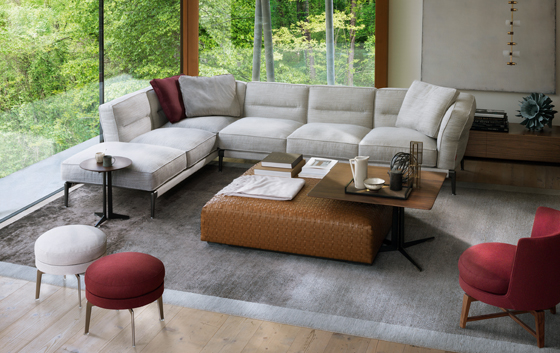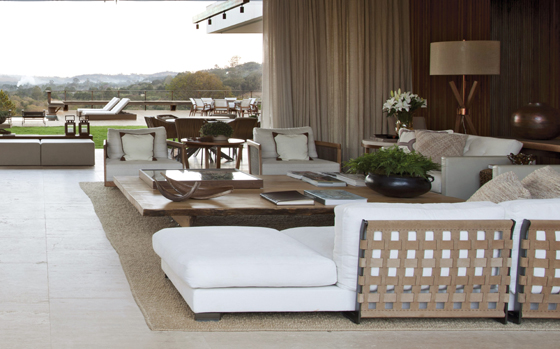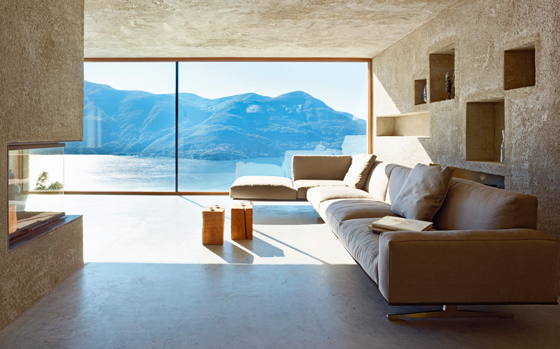A sit-down affair: Flexform
Brand story by Alyn Griffiths
Meda (MB), Italy
21.05.18
For the Italian manufacturer FLEXFORM, the sofa is the most important piece of furniture. Having perfected its comfort, functionality and elegance, getting up is now only in exceptional cases necessary.
The sectional sofa Adda by Antonio Citterio design (2017)
“Every sofa is a constellation of different functions,” according to Antonio Citterio, whose designs for leading Italian brand Flexform have helped to redefine the role of the sofa in contemporary living environments. Flexform’s philosophy places the sofa at the heart of the home, with other products such as armchairs, tables and ottomans performing supporting roles in the creation of spaces dedicated to ultimate comfort and relaxation.
For Flexform, a sofa is not just for sitting. In the modern home it performs multiple roles, as a space for reading, watching television, working on a laptop, or even eating. Under the creative direction of globally renowned architect and designer Antonio Citterio, the company pioneered the concept of multi-sectional sofas, which can be configured in a wide variety of formats to meet the specific needs of their users. Modular elements combine to create seating landscapes that can be augmented by the inclusion of storage units, table surfaces or chaise longue sections, resulting in a relaxation environment that reduces the need for additional furniture.
Flexform revolutionised the concept of the sofa with its best-selling Groundpiece system, which was designed by Antonio Citterio in 2001 to promote a more informal style of lounging. Top: Private apartment by Francesc Rifé Studio; Photo: Fernando Alda

Flexform revolutionised the concept of the sofa with its best-selling Groundpiece system, which was designed by Antonio Citterio in 2001 to promote a more informal style of lounging. Top: Private apartment by Francesc Rifé Studio; Photo: Fernando Alda
×Flexform’s innovative approach to sofa design is informed by decades of experience developing and manufacturing high-end furniture for the home. The company was founded by the Galimberti brothers in 1959 in the traditional furniture-making region of Brianza, and has remained in the family ever since. Like many of the firms based in and around the town of Meda, it believes strongly in the importance of manufacturing its products entirely in Italy, using local materials wherever possible.
Whilst the tradition of craftsmanship that Meda is renowned for remains evident in the quality of materials and skilled labour required to produce Flexform’s furniture, the company has also consistently collaborated with top designers to ensure its products are market leading. “The company has always been sensitive to lifestyle changes that are an inevitable consequence of evolving societal trends,” explains Giuliano Galimberti, who is a member of the company’s board and of the third generation of the founding family. “Designing and manufacturing sofas is our core business, so we stay extremely attentive to the market and always look to explore new approaches.”
Citterio, Flexform’s creative director, was also responsible for the Lifesteel sofa, which features large cushions and square armrests raised above the floor on a slender steel base. Top: Private penthouse by Frankly Amsterdam; Photo: Kasia Gatkowska
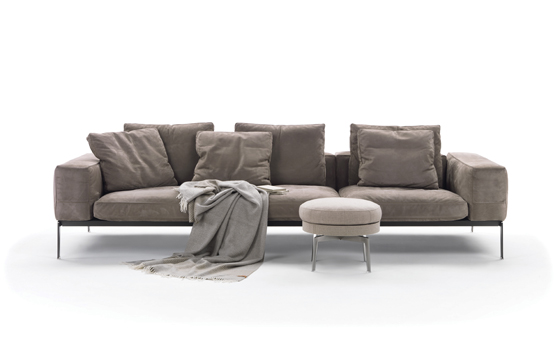
Citterio, Flexform’s creative director, was also responsible for the Lifesteel sofa, which features large cushions and square armrests raised above the floor on a slender steel base. Top: Private penthouse by Frankly Amsterdam; Photo: Kasia Gatkowska
×From the very beginning, Flexform worked with designers such as Joe Colombo, Cini Boeri and Rodolfo Bonetto to develop furniture solutions that were both innovative and influential. With many international bestsellers already behind it, the company was responsible for a key moment in the evolution of sofa design with the launch of its groundbreaking Groundpiece collection in 2001. Antonio Citterio designed the sofa in response to the changing behaviours of modern homeowners. Its added depth encourages lounging, while solid storage elements replace the padded armrests to enhance the product’s functionality.
The success of Groundpiece was followed by several other important products. The Lifesteel sofa (2006) features a modern, geometric outline; Cestone (2008) looks great from any angle thanks to its metal frame wrapped in leather straps; Soft Dream (2010) represents the ultimate in lounging comfort with its deep or extra deep cushions; Evergreen (2012) has a light and delicate look resulting from its slender elevated base topped with cushions and splayed armrests; and Adda (2017) displays distinctive horizontal stitching on its generously padded goose down cushions.
The Cestone sofa is designed to look good from any angle, with supporting panels along the back and sides made from cowhide woven in an attractive checkerboard pattern. Top: Project by Débora Aguiar Arquitetos; Photo: Marco Antonio

The Cestone sofa is designed to look good from any angle, with supporting panels along the back and sides made from cowhide woven in an attractive checkerboard pattern. Top: Project by Débora Aguiar Arquitetos; Photo: Marco Antonio
×A consistent attribute across all of Flexform’s products is an unwavering commitment to understated elegance, which is manifested in the reduced forms and application of a simple palette of honest materials and muted colours. “Our products are easily recognisable through balanced proportions, timeless elegance and design consistency,” claims Giuliano Galimberti. “They perfectly embody the concept that is so happily expressed in the words ‘effortless style’, which describes sofas that are both beautiful and comfortable.”
In recent decades, as consumer tastes have matured and homeowners have embraced more relaxed and sophisticated furniture, Flexform has consistently met the demand for versatile and refined products that contribute to an improved quality of life. “Our clients are demanding and feel the need to find their own style,” Citterio adds. “Like Flexform, they sense that the only way to do this is to demonstrate an innate elegance that requires just a few very carefully chosen pieces for their surroundings.” Looking ahead, the company’s ability to identify and respond to shifting societal demands will ensure its products continue to feel timeless yet utterly contemporary, and perfectly suited to the homes of its discerning customers.
Soft Dream epitomises Flexform’s pursuit of the ultimate in versatile and adaptable sofa systems. Its deep seating elements seem to float on a thin metal tray. Top: Project by: Wespi de Meuron Romeo Architects; Photo: Hannes Henz
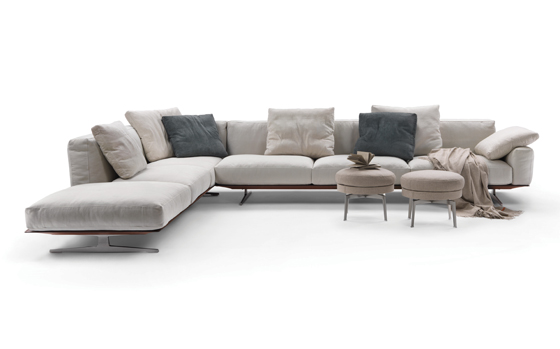
Soft Dream epitomises Flexform’s pursuit of the ultimate in versatile and adaptable sofa systems. Its deep seating elements seem to float on a thin metal tray. Top: Project by: Wespi de Meuron Romeo Architects; Photo: Hannes Henz
ש Architonic

